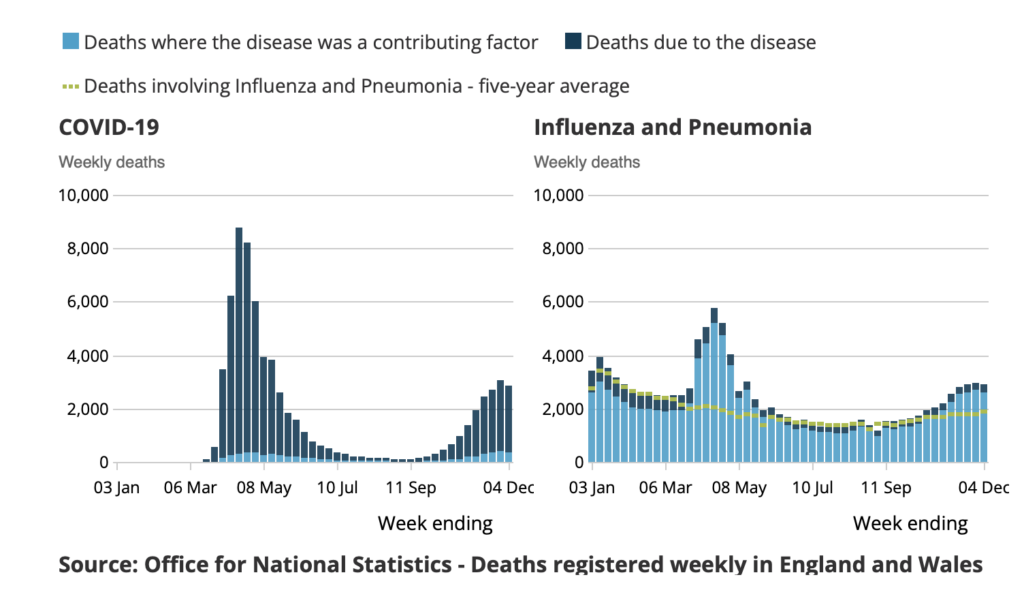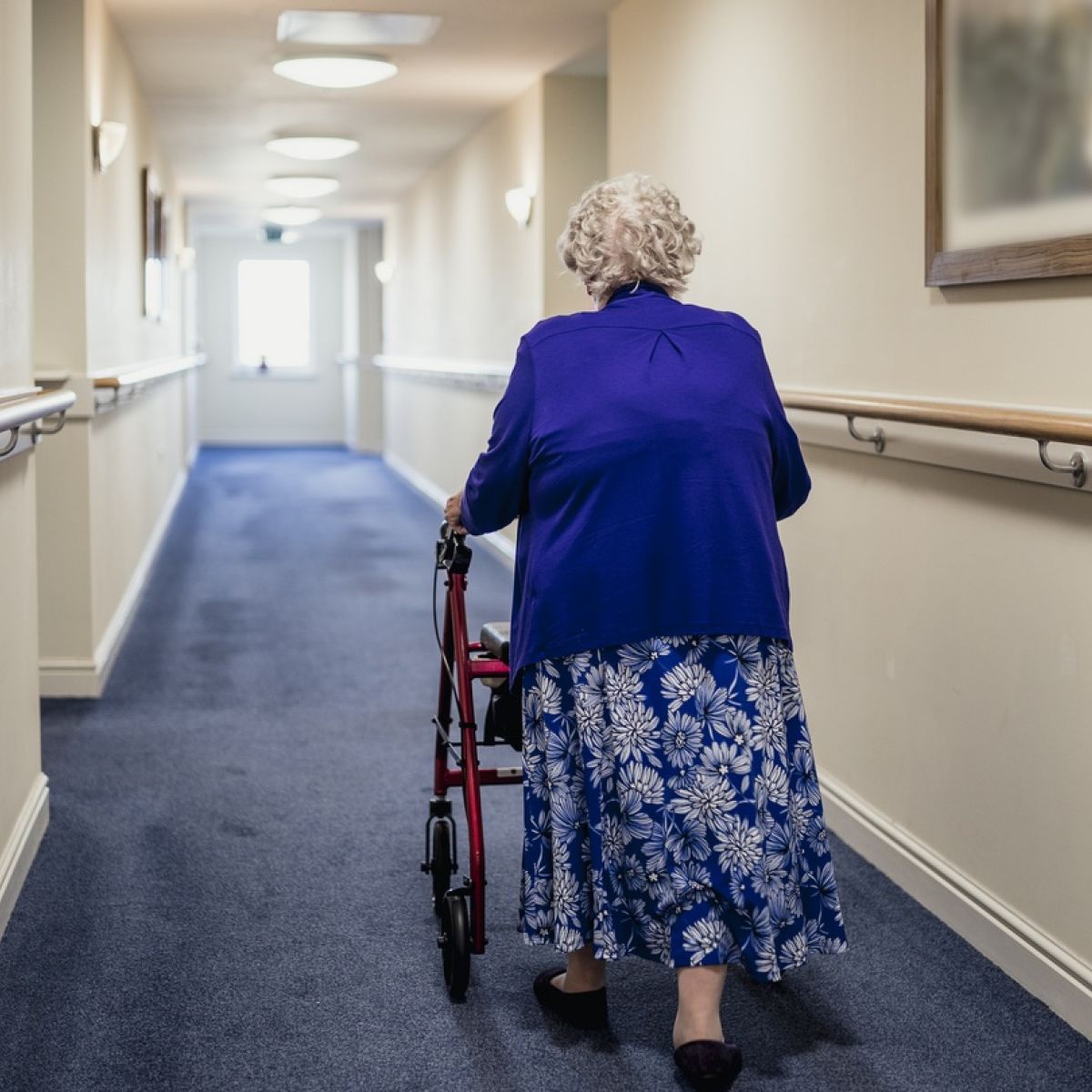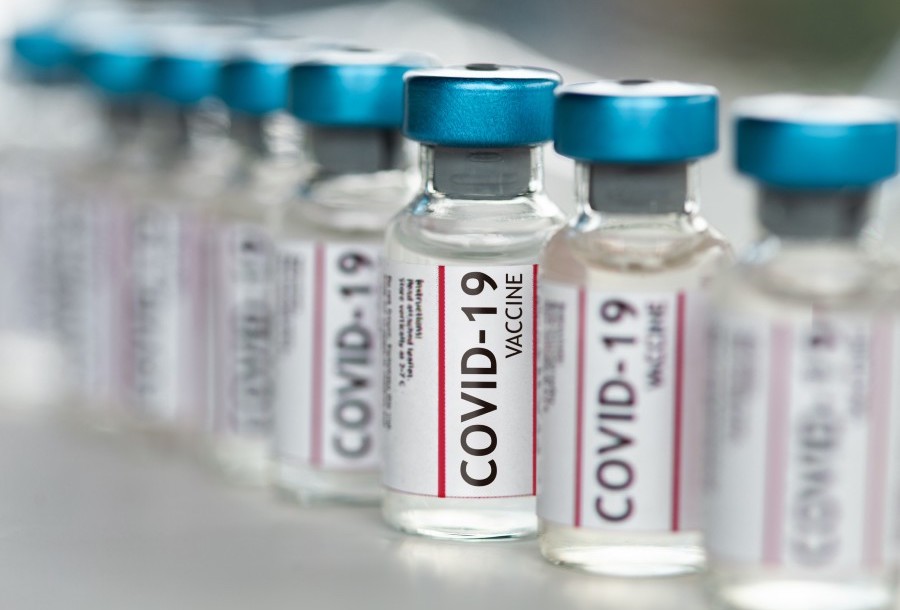There follows a guest post by Dr. David Livermore, Professor of Medical Microbiology in the Norwich Medical School at UEA, who says that counting deaths from COVID-19 is tricky as it’s a pathogen that primarily endangers the already frail or at-risk.
Counting deaths is straightforward when a pathogen kills the healthy, as with ebola or plague. And it wasn’t hard to agree that HIV was the underlying killer to count even when AIDS patients succumbed to unusual fungi and cancers.
It’s not so easy when a pathogen primarily endangers the frail. Many antibiotic-resistant ‘superbugs’ are hard to treat and potentially lethal in a person with leukaemia, but harmless for the fit and healthy. What killed the patient, the leukaemia or the carbapenem-resistant Klebsiella? It’s hard to know, and easy to exaggerate, as when Jim O’Neill predicted 10 million deaths annually from resistant bacteria by 2050.
Similarly for Covid. Consider the unhappy realm of Scotland. As of March 17th, there were 11,075 deaths attributed to SARS-CoV-2, and 13,563 with the virus mentioned on their death certificate. Of these, 29% – around 3,600 – were in care homes. A separate report tells us another 1,986 (around 17%) “probably or certainly” resulted from hospital-acquired Covid, with three quarters of these folks aged over 75 years. So, almost half of all Scottish Covid deaths were ‘healthcare-associated’ (nosocomial) and – almost by definition – were folks with co-morbidities or vulnerabilities. On entering a U.K. care home in the pre-Covid era one had a median life expectancy of 462 days. For nosocomial Covid, mortality was 28.2%, or around 100-fold above the general Covid fatality rate, telling you a lot about the vulnerability of the Scots who succumbed.
This means that, when counting deaths among those infected by SARS-CoV-2 (or, similarly, antibiotic-resistant bacteria) it’s vital, though difficult, to distinguish ‘died with’ and ‘died from’. The death certificate has boxes for “Disease or condition directly leading to death” and “Other significant conditions contributing to death”, but how accurately these are completed is less than clear. A 2012 review by the ONS concluded that around 22% of death certificates were wrong, half of them in respect of the broad underlying cause of death.
Collateral Global’s latest report, by Tom Jefferson and team, explores this subject, reviewing responses from Government and NHS agencies to over 800 FOI requests asking how deaths were attributed in the case of Covid. Numerous inconsistencies emerge, even when the same agency was asked the same question by different enquirers, let alone when the same question was posed in different devolved administrations. Overall, 14 different ways of attributing the cause of death were found. Around 7.6% of care home deaths were attributed to Covid alone, which seems unlikely, given the frailty of the care home population. The authors also note “availability bias”, meaning a propensity to include information that is available – e.g. a Covid test result – whereas other contributory factors in a complex patient might pass unremarked or unsuspected. I’ll come back to that. Notably, few autopsies were done.
In Sweden, a review of 122 community deaths with COVID-19 recorded on their death certificate concluded that 70% had primarily died from other causes, with Covid as a contributory factor. I can’t find a similar review of the U.K., but ONS data suggest that death totals may not be very accurate.
Figure 1, below, charts care home deaths in England from March 2020 to early this year. Note, first, the spike of light blue – supposedly non-Covid – beneath the dark blue Covid deaths in the first wave of March 2020. This light blue far overtops the five-year death average. Either Covid deaths were undercounted (likely) or something unknown was killing care home residents (unlikely).
Second, come to February 2021. Here, Covid is ‘involved’ in nearly half of all deaths, and ‘non-Covid’ deaths are far below the five-year average for pre-Covid years. This might be because numbers of residents were unusually few, but this seems unlikely, because non-Covid deaths had been near-normal in the preceding summer. The likely explanation is that Covid was being counted as ‘involved’ when the virus was inconsequential and the resident would have died anyway.

Next, consider Figure 2, a format that the ONS no longer publishes and upon which I have commented previously. The left-hand panel shows that, for patients dying with known Covid pneumonia in 2020, death was attributed as ‘due to’ the pneumonia in over 90% of cases (dark blue). By contrast – see the right-hand panel – few pneumonia patients without a Covid diagnosis had their deaths listed as ‘due to’ the pneumonia. Yet the May and December peaks on the pneumonia chart coincide with the Covid peaks and must substantially comprise patients with undiagnosed Covid. I believe that this illustrates Jefferson’s “availability bias”. When there was a virology result for a notorious pathogen, there was a much greater propensity to attribute its pneumonia as the cause of death.

Last, there is the chaos of the real world in a crisis.
At the start of the pandemic, the Government established ‘PMART’ teams to visit homes and care homes where someone had died. These comprised a clinician, a police officer and a fire service driver, all uncomfortably trussed in PPE. The clinician could be a nurse, a medical student or some other health professional. Unless foul play was suspected they took the lead in attributing cause of death, with a certificate issued later after review by another medic, who didn’t actually see the deceased.
My friend, a coroner’s pathologist, tells me that the PMART teams preferred to be in and out of the deceased’s residence as swiftly as possible. As he puts it: “It was a perfect time to poison unwanted relatives, telling the clinician they’d been ‘coughing bad and struggling to breathe’.” And, whilst nobody is suggesting that the spring of 2020 was awash hidden murders, it’s hard to believe that the death certificates of the period are particularly precise.
Dr. David Livermore is Professor of Medical Microbiology in the Norwich Medical School at UEA.











To join in with the discussion please make a donation to The Daily Sceptic.
Profanity and abuse will be removed and may lead to a permanent ban.
https://www.foxnews.com/media/rand-paul-shreds-fauci-for-allegedly-lying-dozens-of-times-over-covid-19.amp
I’m hoping he gets successfully prosecuted, he’s such a weasel I think he would ‘sing’ like canary. However I suspect the two most likely scenarios will be a failure to successfully prosecute due to a ‘bought’ judiciary or Dr Fauci may just succumb to covid.
Or ‘suicide’ from a bullet wound to the back of the head.
More seriously, even if this is taken further a milque-toast resolution is inevitable. Absolute best case scenario would be a resignation. If he had any sense he’d resign now, but people like him are too hubristic for this.
Sky News Australia, right from the beginning
Taxpayer funded experiments in Chinese labs ‘far more extensive’ than first thought – YouTube
Paid for by the American tax payer.
So was/is Dr David Martin, right the way back to 2000 and beyond.
I await the next edition of the Highwire – DB must think Fauci is the gift that keeps on giving…
If a group of people base their theories on what ever is the opposite of what there ‘enemys’ theories are, ignoring inconvenient reality or evidence, surely that is a cult – people with these thought processes can not be persuaded with logic as they are illogical.
Broadly it’s the US “Orange Man Bad” cult that has driven a lot of the most disastrous events of the past 18 months, at least as they’ve manifested within the US sphere.
Now they are having to look around for other things to blame, to divert attention from the obviously senile, corrupt incompetence of the cipher they appointed to replace the Orange Man.
Much worse than that. They are devoted to a Marxist agenda with levels of ruthless control shared with Fascism.
Wrong headline. “Left wing media ignore “lab leak” evidence”
Not just ignore, actively colluding with social media to suppress via censorship, and sneer via “fact checking” that is nothing of the sort
China is not the enemy of the Overclass the 0.1% who who make fortunes from collaborating with the transnational criminal organisation the CCP. Biden is a bought and paid for lackey of the Overclass. MSM outfits are their ‘lickspittle capitalist running dogs’.
This is one of the best videos you will see relative to the topic. This is all about the implosion of the financial industry that should have happened 11 years or more ago.
https://odysee.com/@LongXXvids:c/Ernst-Wolf-speech—summary:3
“right wing” = “not actively stalinist”
The evidence for a lab-leak is overwhelming but left leaning sources are much more likely to cover it up. I didn’t realise till today that the Daily Sceptic discounted right-wing sources, on the basis of being right wing. What’s going on? 900 pages of data implicating Fauci in Wuhan gain of function experiments were released yesterday – this is not left or right wing information, it is just information, so why isn’t the Daily Sceptic covering it? The Daily Sceptic presents itself as a refuge against left wing “woke” politics so who is Noah Carl trying to impress? This is one of the oddest articles I have ever read: it might even seem odd in the Guardian.
Mickey mouse analysis : “the left’s dislike for the lab leak”.
The right didn’t like it much either, and in fact the worn-out political definitions don’t work in any of this. The underlying problem for Covid proponents is that it puts human agency centre stage in this ‘terrifying’ phenomenon. Much better if totally unpredictable, and naturally induced at random.
Of course, identifying US Democrats as ‘left’ in any meaningful sense is also nonsense – they are part of the corporate duality.
They are extremely left and state intervention in the economy is always leftist, no matter who the recipient is.
Congratulations. You’ve just defined the Europe of absolute monarchy and a lot of common economic practice up to 1945 as leftist (whatever). Eg, agricultural protectionism to support the landed gentry.
Are republicans “left wing” – or does it depend what country they’re in?
Even if it is true (which seems fairly likely), chances are there will never be any actual confirmation one way or the other – to many people (including governments) have too much to lose to allow it.
The evidence is already overwhelming – thousands of pages of it. The fact that governments and even the Daily Sceptic are playing cat and mouse over admitting it has nothing to do with “confirmation”, the documents exist confirming it and the cover up, which for some reason the Sceptic seems to be participating in.
“Theories of accidental release from a lab and zoonotic spillover both remain viable,” the letter said.
There is a lot of circumstantial evidence to suggest a third theory that rogue elements of the US deliberately released the virus to harm China and Iran and didn’t realize it would spread around the world.
https://www.unz.com/runz/american-pravda-the-covid-epidemic-as-lab-leak-or-biowarfare/
You would thing that it would be highly unlikely that they would not realise that it would spread to them. However, given their earlier experience with producing weaponised computer viruses, I can certainly see how they might ignore it…
Why on Earth wo wouldn’t they realise it would spread round the world? I thought that’s what viruses do in these interconnected times (though admittedly there were Chinese in Britain over a thousand years ago).
They assumed it would be similar to SARS and mostly stay at the point of first infection.
Nope, it was deliberate:
This is another “bombshell” moment folks and Messr Daszak and Fauci would appear to be in very deep shit….
“Surprise Surprise – Fauci Lied Again”: Rand Paul Reacts To Wuhan Bombshell | ZeroHedge
Or a 4th theory that the virus was deliberately ‘leaked’ with the full knowledge it would indeed spread around the world.
The way the whole affair has been handled has given rise to many wealthy vested interests making great gains from this:
Big Pharma (Obviously)
The banks (Money printing)
Big Business (decimation of small businesses)
Big government (massive power grabs)
The Democrats (rigged election)
You can also foresee a Chinese style credit system making its way here, and globally in the West. Cashless society etc.
Perhaps it is all about control, because that is exactly what it feels like. A mass psychosis has been blanketed on the public using fear as the main driver. The governments, media and the people all ignore real world data and focus on the fearmongering. And that has been done for a reason. It certainly isn’t for as something as pathetic as SARS-CoV2.
WHY DOESN’T THE DAILY SCEPTIC ADDRESS THE MASSIVE BODY OF EVIDENCE RELATING TO FAUCI, GAIN OF FUNCTION EXPERIMENTATION AND THE WUHAN LAB, INSTEAD OF PRODUCING THIS NONSENSE FROM NZ WHICH IS ABSOLUTELY NOT WORTH READING IN FULL???
Long thought TY & co should provide links to this evidence ……very very difficult for Fauci and by association all those named in these and other emails to avoid investigation: Drosten, Zhengli, Farrar, Vallance ( YEP VALLANCE) Daszak..but then if the “Judiciary” are onside it won’t happen this side of civil war.
I think the DS should ask itself what the average Guardian reader would assume about the content of the article, based on the headline. It is all to obvious that they would assume that the lab leak theory was a conspiracy theory, and that it was being promulgated by right wing media like the Telegraph (lol).
“Left wing media suppress lab leak evidence. Conservative leaning media does not”. There you go, fixed it for you. That might even work for the average Tory voter.
The Telegraph that was a Liberal party supporting newspaper until it fell out with them over Turkey (or was it Ireland?) and now supports the liberal “not the Conservative party”?
I think the Morning Post was a bit more right of centre, though I’m not sure how it ended up when the Telegraph took over (Lord Deedes worked for both papers).
Thats so funny to think of this military grade pathogen being deployed from a bat lab in China….a brilliant red-herring cover story 😊
…….the man’s critics (of whom there are plenty in the mainstream media) ……..
…the man’s critics (who ARE the mainstream media) ….
There. Fixed that for you…
Personally, I think the ‘lab leak theory’ is the acceptable ‘conspiracy theory’.
This has been too well planned, with many many vested interested making gains on it for it to be an accidental leak. I am not disputing the game of function research etc, but this is most certainly deliberate.
Good point
US labs at BSL 4 were stopped doing, for a while, GoF research in/around 2014; Wuhan lab finished with French lab assistance in …late 2014, with BSL2,3 and 4 capacity.
Leaks have happened before; agree GoF is a sustained deliberate tranche of research and US /China ( UK to at P.Down) regarding Coronaviruses back to 1990and before ( Follow the Patent trail set out by Dr David Martin ….very damning).
Fauci has lied serially about GoF before, during and after the US moratorium. Dr Martin has very clearly stated that he has supplied US Intelligence agencies with his information from 2000 or so onwards. Why have “they ” not acted on it – how has this man been allowed to continue “in post” when he has questions to answer about HIV/AIDS/Remdesivir…?
My first hearing of this ‘theory’ was from a respected pharmacologist who had the information direct from the ‘source’. All else is theatre and piffle. The law is still on our side. The truth will win. The liars will be held to account. Fight back on an individual level. Others will follow. Useful information, resources and links: https://www.LCAHub.org/
The theory I heard was approximately 18 months ago by the way… at the very start of this masquerade…
Yes, Fauci called a meeting 1 February 2020 with Farrar and others, notably Patrick Vallance, to discuss how they were going to dispel the rumours. This article still seems to be doing it: a sociologist’s manoeuvre – instead of checking the evidence for the story you categorise the kind of people who believe it.
How many times has Vallance confirmed he has an ethical Conflict of Interest due to his prior knowledge and therefore involvement in GoF, chimerically derived SARS COV2 ….
Four legs good. Two legs bad. Masks good. No masks bad. (Have you seen the pathetic sheep on the opposition benches in their ludicrous masks?)
They don’t think for themselves. The groupthink says that Trump is bad, everything he has ever said is bad, ipso facto non-Trump equals good. You can’t reason with nut jobs.
So left wing Intercept now releasing documents apparently showing Fauci lied? Is the bus coming and are they getting ready to throw him?
https://nypost.com/2021/09/07/wuhan-lab-documents-show-fauci-untruthful-about-research-critics/
It’s also worth noting that the zoonotic hypothesis suits those promoting eco-conciousness, as it the highlights the possibility that increasing encroachment on wildlife habitats may increase the spread of pathogens.
Look up ‘Trusted News Initiative’. Left leaning news outlets have banded together to agree not to report stuff which goes against the Fauci/CDC/Big Pharma narrative.
Ah!!!! The first politically active Virus. Will it succeed to get Trump back in the White House?
Read this then tell me it wasn’t a lab leak.
https://nicholaswade.medium.com/origin-of-covid-following-the-clues-6f03564c038